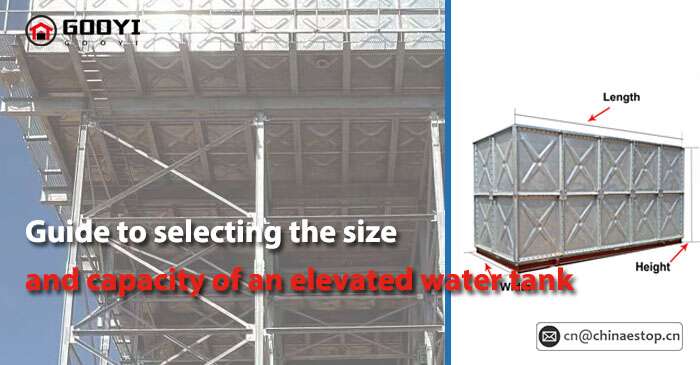Guide to selecting the size and capacity of an elevated water tank
Choosing the size and capacity of an overhead water tank is a decision-making process based on a number of factors. The right size and capacity should not only meet current needs, but also take into account the possibility of future expansion. The following is a detailed sizing and capacity selection guide:

-
Determine the average daily water consumption
Evaluate demand: First, you need to evaluate the average daily water consumption of the service objects. This includes the different needs of residential, commercial and industrial users.
Collect data: If possible, collect actual water consumption data over a period of time to accurately estimate average water consumption.
Seasonal fluctuations: Consider seasonal changes in water consumption, especially peak water consumption in situations such as agricultural irrigation and peak tourism season.
-
Reserve peak demand
Peak demand: Consider additional demand during peak water consumption times of the day (such as morning and evening).
Special events: Consider the surge in water consumption that may occur during special activities or events.
Redundant capacity: It is generally recommended to add at least 10% to 20% additional capacity as redundancy to cope with unforeseen water needs.

-
Consider future growth
Population growth: If the service area is expected to have new residents or new businesses, a certain amount of capacity needs to be reserved to cope with future population growth.
Business expansion: For commercial and industrial users, consider the possibility of business expansion in the next few years.
Infrastructure development: Consider the development plan of infrastructure in the area, such as new residential areas or industrial areas.

-
Choose size according to purpose
Residential use: For residential areas, the size of the water tank is usually determined based on the number of families and living habits.
Commercial use: Commercial places may need larger water tanks to meet frequent water needs.
Industrial use: The capacity of water tanks for industrial use needs to be determined according to the specific requirements of the production process.
- Installation height and water pressure requirements
Water pressure requirements: Determine the installation height of the water tank based on the minimum water pressure required to ensure that sufficient water pressure can be provided even during peak water use.
Topographic factors: Consider the terrain characteristics of the installation site to ensure that the water tank can be stably installed and easy to maintain.

-
Economic feasibility analysis
Cost-benefit ratio: Compare the cost-effectiveness of water tanks of different capacities and choose the most cost-effective solution.
Long-term return on investment: Consider the total cost of ownership (TOC) of the tank over its entire lifecycle, including long-term expenses such as maintenance and replacement parts.
Selecting the size and capacity of an overhead water tank is a multifaceted task. With an accurate assessment of water demand, a reasonable forecast of future developments, and an in-depth analysis of economic feasibility, you can pick the tank size and capacity that best suits your needs. In addition, ensuring that the selected tank meets local regulations and standards is key to ensuring a safe and reliable water supply system.

Inquiry please contact:
Email : cn@chinaestop.cn
Whatsapp✆:+86 15350598856
Web: www.chinaestop.cn
————————————————————————————————————————
“ Wish to be your best partner in China! Welcome to visit our company”
